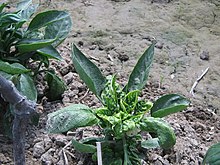Pepper leaf curl virus
| Pepper leaf curl virus | |
|---|---|

| |
| Leaf curl virus | |
| Virus classification | |
| (unranked): | Virus |
| Realm: | Monodnaviria |
| Kingdom: | Shotokuvirae |
| Phylum: | Cressdnaviricota |
| Class: | Repensiviricetes |
| Order: | Geplafuvirales |
| Family: | Geminiviridae |
| Genus: | Begomovirus |
| Species: | Pepper leaf curl virus
|
Pepper leaf curl virus (PepLCV) is a DNA virus from the genus Begomovirus and the family Geminiviridae. PepLCV causes severe disease especially in pepper (Capsicum spp.). It can be found in tropical and subtropical regions such as Thailand and India, but has also been detected in countries such as the United States and Nigeria. This virus is transmitted by an insect vector from the family Aleyrodidae and order Hemiptera, the whitefly Bemisia tabaci. The primary host for PepLCV are several Capsicum spp..[1] PepLCV has been responsible for several epidemics and causes severe economic losses. It is the focus of research trying to understand the genetic basis of resistance. Currently, a source of resistance to the virus has been identified in the Bhut Jolokia pepper.[1]
Genome
This virus consists of a single circular single-stranded (ss) DNA molecule (2744 nt in size), and betasatellite, which is a common distinction among viruses in the family Geminiviridae.[2] The betasatellite associated with PepLCLV in Capsicum was identified as Chili leaf curl betasatellite (ChLCB).[3] This virus has similar coat protein structure and genome organization to that of other begomoviruses such as TYLCV.
Transmission
PepLCV is transmitted by the insect vector Bemisia tabaci in a persistent-circulative nonpropagative manner. Transmission is most damaging when plants are infected at early growth stages, preventing the proper formation of flowers and pollen resulting in zero to low fruit production.[4]
Agricultural importance
Symptoms of PepLCV infection include severe stunting, flower bud abscission, reduction in pollen production, reduction of leaf size, upward cupping/curling of leaves, chlorosis on leaves and flowers, and reduction or elimination of fruit production. This virus can cause significant yield losses, and in the case of mixed infections or pests such as thrips or mites, losses may be as severe as 90–100%.[4] Treatments that are commonly used for this disease include insecticides, border crops, and growing varieties with genetic resistance.[1]
Epidemiology
PepLCV is found in tropical and subtropical regions, and it significantly affects pepper production around the world. This virus was first detected in India around 1960,[5] and now it occurs worldwide. PepLCV has been found in different countries from Africa, Asia, and Central and North America. There are closely related virus species including:
- Pepper leaf curl Bangladesh virus[6]
- Pepper leaf curl Lahore virus[7]
- Pepper leaf curl Yunnan virus[8]
PepLCV is related to Chilli leaf curl virus (ChiLCV), but it is a different species. Comparison of the sequence of PepLCV with previously characterized begomoviruses shows it likely to have resulted from recombination between Papaya leaf curl virus and ChiLCV.[3]
Management
Currently, the most widespread treatments used to control the spread of PepLCV are insecticides and new resistant crop varieties. The usage of large quantities of insecticides to control vector populations is not ideal, and other cultural methods to control vector populations are of increasing importance to a complete integrated pest management strategy. Other methods to control the spread of PepLCV include planting resistant/tolerant lines, crop rotation, and border plantings.[1]
References
- ^ a b c d Rai, Ved Prakash; Kumar, Rajesh; Singh, Sheo Pratap; Kumar, Sanjay; Kumar, Sanjeet; Singh, Major; Rai, Mathura (June 2014). "Monogenic recessive resistance to Pepper leaf curl virus in an interspecific cross of Capsicum". Scientia Horticulturae. 172: 34–38. doi:10.1016/j.scienta.2014.03.039.
{{cite journal}}: Unknown parameter|name-list-format=ignored (|name-list-style=suggested) (help) - ^ "RefSeq: NC_000882". www.genome.jp. Retrieved 2018-07-09.
- ^ a b Tahir M, Haider MS, Briddon RW (April 2010). "Chili leaf curl betasatellite is associated with a distinct recombinant begomovirus, Pepper leaf curl Lahore virus, in Capsicum in Pakistan". Virus Research. 149 (1): 109–14. doi:10.1016/j.virusres.2009.12.007. PMID 20079779.
- ^ a b Kumar, Sanjay; Kumar, Sanjeet; Singh, Major; Singh, Ashok Kumar; Rai, Mathura (November 2006). "Identification of host plant resistance to pepper leaf curl virus in chilli (Capsicum species)". Scientia Horticulturae. 110 (4): 359–361. doi:10.1016/j.scienta.2006.07.030.
{{cite journal}}: Unknown parameter|name-list-format=ignored (|name-list-style=suggested) (help) - ^ Senanayake, D. M. J. B.; Varma, Anupam; Mandal, Bikash (2012-01-25). "Virus-vector Relationships, Host Range, Detection and Sequence Comparison of Chilli leaf curl virus Associated with an Epidemic of Leaf Curl Disease of Chilli in Jodhpur, India". Journal of Phytopathology. 160 (3): 146–155. doi:10.1111/j.1439-0434.2011.01876.x.
{{cite journal}}: Unknown parameter|name-list-format=ignored (|name-list-style=suggested) (help) - ^ Raj SK, Snehi SK, Khan MS, Tiwari AK, Rao GP (2010). "First report of strain associated with bitter gourd (Momordica charantia L.) yellow mosaic disease in India". Australasian Plant Disease Notes. 5 (1): 14. doi:10.1071/dn10006.
- ^ Shafiq M, Asad S, Zafar Y, Briddon RW, Mansoor S (December 2010). "Pepper leaf curl Lahore virus requires the DNA B component of Tomato leaf curl New Delhi virus to cause leaf curl symptoms". Virology Journal. 7: 367. doi:10.1186/1743-422X-7-367. PMC 3017532. PMID 21144019.
{{cite journal}}: CS1 maint: unflagged free DOI (link) - ^ Xie Y, Zhou XP (October 2003). "Molecular characterization of squash leaf curl Yunnan virus, a new begomovirus and evidence for recombination". Archives of Virology. 148 (10): 2047–54. doi:10.1007/s00705-003-0153-2. PMID 14551824.
External links
- "Description of Family Groups". The Big Picture Book of Viruses.
- Waterworth, Kristi. "Pepper Leaves Rolling?". Gardening Knowhow.
{{cite web}}: Unknown parameter|name-list-format=ignored (|name-list-style=suggested) (help) - "Bemisia tabaci distribution". Invasive Species Compendium.
